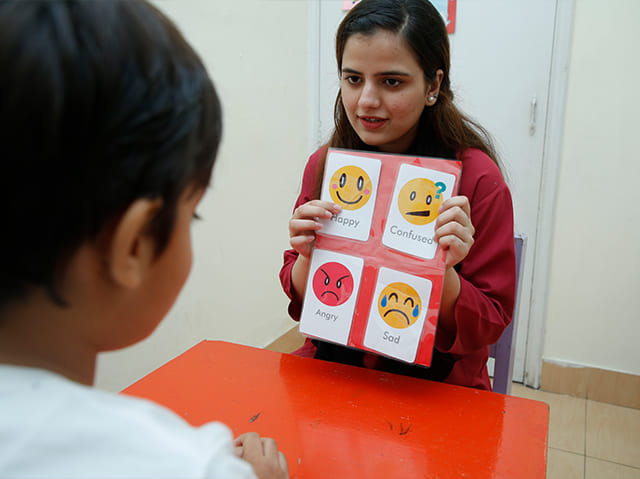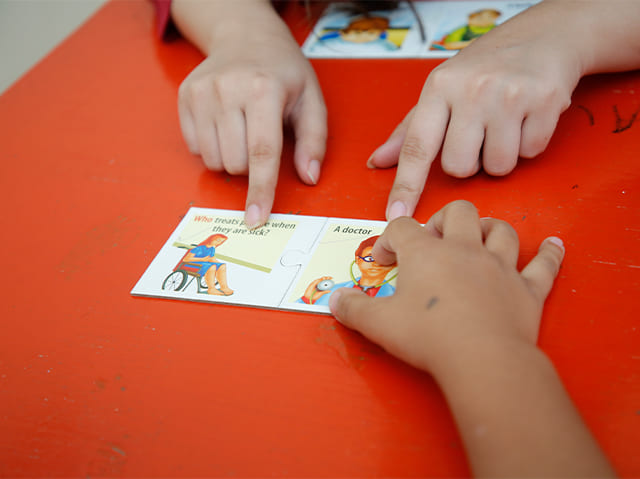Echolalia is a form of Language
Echolalia is a form of language with verbal imitation. Echolalia includes meaningless replication of another person’s spoken words, phrases, and sentences. Children develop echolalia between the ages of 2-3 years. Mostly we observe echolalia in Autism Spectrum Disorder, speech-language delay, and hearing impairment. There are a lot of reasons that lead to the development of echolalia including poor receptive language, oral-motor deficits, limited vocabulary, and sensory stimulation. According to researchers, a child diagnosed with Autism Spectrum Disorder learns language in chunks. This learning style is called a “gestalt” style of language acquisition. A child with apraxia of speech has poor imitation skills because of damage in the parts of the brain: Inferior Frontal Gyrus, Insula, and Inferior frontal lobe. Because of this impairment, they start to repeat our conversations. According to my observation, echolalia is good for children diagnosed with childhood of apraxia. We can improve their imitation skills and motor planning with the help of echolalia. Most of the time, a child repeats conversation to manage their emotions, thoughts and behaviors. Through echolalia, we can determine the level of language and improve communication skills. We divide echolalia in two types:
- Immediate echolalia.
- Delayed echolalia.
In Immediate echolalia, the child repeats words and sentences after the communicative partner. For example, the therapist asks “Moosa, Are you a boy?” and he will repeat at the same moment “Are you a boy?” In this case, Moosa may or may not know about his name. In Delayed echolalia, a child memorizes information and dialogues of his favorite character and repeats them after a period of time. 75% of children with Autism and speech-language delay exhibit echolalia in one way or another.
During initial therapeutic interventions, we need to be aware while working with echolalia
- Don’t ask Questions: Initially, don’t introduce questions to the client. Clients face problems in answering questions because they have a poor understanding of questions.
- Binary Choice: Don’t offer them choices in the start. Clients with poor understanding will repeat both choices given by the therapist/ parents.
- Self-Talk: We need to reduce their self-talk. It is a big hurdle in learning new concepts. They repeat your questions in a form of delayed echolalia.
- Sentence Structure: Your Sentences must be short in the beginning when child is learning new concepts. Try to use short phrases for communication.
- Don’t take child’s name at the end of the sentence: Try to avoid praising child using their name, such as “Good job, Ahil” and when greeting your child “Hello, Ahil”.
Being a speech-language pathologist, I use different techniques to deal with echolalia
- Improve Vocabulary: Children with speech language delay and other speech disorders have limited vocabulary. Because of limited vocabulary, they don’t use proper grammatical components in their sentences.
- Complete the incomplete Sentence: It would be a fun activity. You can hold their favorite activity in your hand and ask them to complete your sentence by saying “I want to play with …..” In the case of no response, use gestural prompts by pointing towards the desirable object. After noticing your response, they will definitely try to complete your sentence.
- Model Correct Response: Modeling is one of the best strategies when working with Autism Spectrum Disorder and other speech-language disorders having echolalia. During the session, we can introduce a model to the child. For example: if the child doesn’t like any activity or food item, then use a model who will answer on their behalf. For examples, “Do you want to eat rice?” Model will give immediate response on the question. ‘NO’ Then slowly fade the model until the child can provide the previously given answer independently.
- Offering Choices: To reduce echolalia, use statements instead of asking questions and offer two desirable stimuli at a time without questioning intonation. For example, “Do you want chips or cookies?” After presenting two options, use a gestural prompt and label the desired activity spontaneously.
- Negation Concept: To manage echolalia,teach yes/ no response to the child in response to questions, for example: “Are you happy?” Or “Do you want to go outside?”
- “I don’t know” response: Teach ‘I don’t know’ response to the child to avoid repetitive speech. Firstly make a list of some new questions for the client and ask them to answer mentioned questions. Child’s facial expression will communicate whether he knows the answer or not. Then introduce the ‘I don’t know’ statement in response to a new questions.
- Literally response: If the child starts to repeat your questions instead of answering, give a literal response to their questions. For example, if we ask, “Do you want a ball?” and the child repeats, “Do you want a ball?” then therapist will answer in “No, I don’t need a ball”.
- Preferred and Non- Preferred items: Pair preferred and non- preferred items in a statement. Use non-preferred itemsatthe end of the statement as children with speech issues mostly repeat the last words in a sentence.For example, if you ask, ‘ Do you want a car or book?’ Child will repeat the last word spoken by the therapist or parent ‘book’. Then give them an immediate response and provide the item.e.g. ‘book’. The child will refuse to take it. In the next trial, we can provide him gestural prompt by pointing towards the card.
- Use Visual and Scripted Responses:For example, Initially, a picture of a boy performing any action will be pasted on a file. A statement related to this picture will be given to the child. Therapist will ask “Who is playing with ball?” and give immediate response ‘boy’.
- Yes/ No Response: To reduce echolalia, we can teach them yes/ no response. For example, the therapist will ask “Do you want turtle?” Yes or no? If the child will repeat the last word ‘No’. You don’t need to provide his favorite reinforcer to him. In the next trial, provide a spontaneous response: Yes! Fade away prompt after they have learnt the correct response.
- Use Gestural Cues: Use gestural cues instead of asking questions or statements. Hold the child’s finger and keep it on the target picture, for example, on a story book. Don’t speak until the child focuses and observes the presented stimulus.
In short, most of the time echolalia seems frustrating but it is a blessing for those who find it difficult to communicate for their needs. Sometimes echolalia is a child’s response to calm their sensations when their system is overstimulated. When you observe that your child is echoing words, provide them the opportunity to learn new concepts of language.
Speech Language Pathologist
Khadija Abbasi



